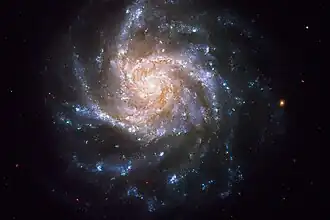NGC 1376
| NGC 1376 | |
|---|---|
 A Hubble Space Telescope (HST) image of NGC 1376 | |
| Observation data (J2000 epoch) | |
| Constellation | Eridanus |
| Right ascension | 03h 37m 05.80s[1] |
| Declination | −05° 02′ 36″[1] |
| Redshift | 0.013873±0.00003[1] |
| Distance | 180 Mly (55.1 Mpc)[2] |
| Apparent magnitude (V) | 12.1[2] |
| Characteristics | |
| Type | SA(s)cd[1] |
| Size | 71,000 ly |
| Apparent size (V) | 1.95 x 1.82[3] |
| Notable features | Older stars near core |
| Other designations | |
| IRAS 03346-0512,[1] MCG-01-10-011,[1] PGC 13352,[1] GSC 04722-00875[1] | |
NGC 1376 is a spiral galaxy located around 180 million light-years away in the constellation Eridanus.[1] It was discovered in 1785 by William Herschel, and it is 79,000 light-years across.[1] NGC 1376 is not known to have an active galactic nuclei, but it does have lots of star-forming regions.[2][3]
Characteristics
Concentrated along the spiral arms of NGC 1376, bright blue knots of gas highlight areas of active star formation.[4] These regions show an excess of light at ultraviolet (UV) wavelengths because they contain brilliant clusters of hot, newborn stars that are emitting UV light.[2] The less intense, red areas near the core and between the arms consist mainly of older stars.[4][2] The reddish dust lanes delineate cooler, denser regions where interstellar clouds collapse to form new stars.[1] Behind the spiral arms is a sprinkling of reddish background galaxies.[2]
NGC 1376 belongs to a class of spirals that are seen nearly face on from our line of sight.[1] Its orientation aids astronomers in studying details and features of the galaxy from a relatively unobscured vantage point.[2]
Supernovae
Three supernovae have been observed in NGC 1376:
- SN 1999go (Type II, mag. 15.5) was discovered by the Lick Observatory Supernova Search (LOSS) on 23 December 1999.[5][6] Its luminosity rivaled the brightness of the entire galactic nucleus (as seen from ground-based telescopes) for several weeks.[2]
- SN 2003lo (Type IIn, mag. 17.2) was discovered by Tim Puckett and B. Kerns on 31 December 2003.[7][8]
- SN 2011dx (Type Ia, mag. 16.5) was discoverd by L. A. G. "Berto" Monard on 27 June 2011.[9][10]
References
- ^ a b c d e f g h i j k l "By Name | NASA/IPAC Extragalactic Database". ned.ipac.caltech.edu. Retrieved 2023-11-25.
- ^ a b c d e f g h "Spiral galaxy NGC 1376". www.spacetelescope.org. Retrieved 2023-09-10.
- ^ a b "NGC 1376 - Spiral Galaxy in Eridanus | TheSkyLive.com". theskylive.com. Retrieved 2020-06-29.
- ^ a b "NGC 1376 - Galaxy - SKY-MAP". www.wikisky.org. Retrieved 2022-02-08.
- ^ Papenkova, M.; Li, W. D. (1999). "Supernova 1999go in NGC 1376". International Astronomical Union Circular (7337): 1. Bibcode:1999IAUC.7337....1P.
- ^ "SN 1999go". Transient Name Server. IAU. Retrieved 4 August 2025.
- ^ Puckett, T.; Kerns, B.; Toth, D. (2004). "Supernovae 2003lo and 2003lp". International Astronomical Union Circular (8261): 2. Bibcode:2004IAUC.8261....2P.
- ^ "SN 2003lo". Transient Name Server. IAU. Retrieved 4 August 2025.
- ^ Monard, L. A. G.; Prieto, J. L. (2011). "Supernova 2011dx in NGC 1376 = PSN J03370500-0501560". Central Bureau Electronic Telegrams (2759): 1. Bibcode:2011CBET.2759....1M.
- ^ "SN 2011dx". Transient Name Server. IAU. Retrieved 4 August 2025.
External links
 Media related to NGC 1376 at Wikimedia Commons
Media related to NGC 1376 at Wikimedia Commons